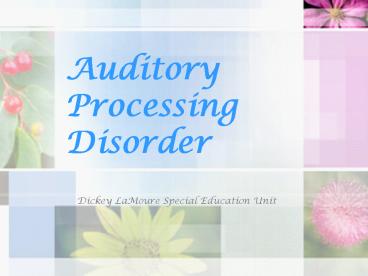Auditory Processing Disorder - PowerPoint PPT Presentation
1 / 16
Title:
Auditory Processing Disorder
Description:
The brain 'processes' the ... Causes of Auditory Processing Disorder. Often unknown ... Autism or Autism spectrum disorder. Specific language impairment ... – PowerPoint PPT presentation
Number of Views:322
Avg rating:3.0/5.0
Title: Auditory Processing Disorder
1
Auditory Processing Disorder
Dickey LaMoure Special Education Unit
2
How Does Auditory Processing Work?
- The ears detect sound
- Auditory stimulus travels along the neural
pathways from the ear to the brain - The brain processes the information, allowing
the listener to - Determine where the sound comes from
- Determine what type of sound it is
- Separate the sound from background noise and
- Interpret the sound.
- The listener stores, retrieves, or clarifies the
information to make it useful.
3
Causes of Auditory Processing Disorder
- Often unknown
- May be associated with the following conditions
- Dyslexia
- Attention deficit disorder
- Autism or Autism spectrum disorder
- Specific language impairment
- Pervasive developmental disorder
- Developmental delay
- Or, it may occur on its own
4
Auditory Processing Disorder
- Children with Auditory Processing Disorder (APD)
have trouble decoding sounds. - The disorder part of APD is an impaired ability
to - attend to,
- discriminate,
- remember,
- recognize, or
- comprehend
- information presented auditorily.
5
Characteristics of APD
- All learning is negatively affected by APD.
- Difficulty following directions is the most
common complaint about children with APD.
Students cannot - Interpret oral directions
- Follow directions in the correct sequence
- Organize information presented
- Come to appropriate conclusions regarding data
- Categorize and compare data.
6
Characteristics of APD
- Poor reading, comprehension, writing, and
spelling - Weak short-term memory
- Difficulty taking notes
- Difficulty learning foreign languages
- Verbal (word) math problems are difficult.
7
Characteristics of APD
- Children with APD often do not recognize subtle
differences between sounds in words, for example
- "Tell me how a chair and a couch are alike"
- may sound like
- "Tell me how a couch and a chair are alike."
- or
- "Tell me how a cow and a hair are alike."
8
Characteristics of APD
- Auditory processing difficulties become more
pronounced in challenging listening situations - noisy backgrounds
- poor acoustic environments
- great distance from the speaker
- speakers with fast speaking rates
- speakers with foreign accents.
- Assistive listening devices may help.
9
Characteristics of APD
- Problems understanding language developing
vocabulary - Poor language and academic skills may lead to
further problems - Behavioral,
- Psychological, and/or
- Social problems.
10
Classroom Accommodations
- Use visual cues
- List assignments on the board
- Provide lecture outlines
- Use demonstrations and examples to clarify
information - Step out directions
- Use graphs or posters help students visualize the
information or concept.
11
Classroom Accommodations
- Use texts on CDs (check when ordering new texts)
- Ask students to fill in or predict information in
class and conversations - Repeat directions
- Give the child time to respond to questions
- Prepare the child in advance by giving the
question and making sure he has the answer.
12
Classroom Accommodations
- Allow the child to use a tape recorder or peer
note-taker - Use a cloze procedure for note taking
- Draw out math problems
- Use diagrams
- Develop memory techniques verbal rehearsal and
mnemonics (chunking, cueing, chaining).
13
Classroom Accommodations
- Use descriptive adjectives that express sensory
input - Provide models of paraphrasing or give the
student 2 choices of how to paraphrase - Reduce noise increase structure
- Give 1 direction at a time gradually build up to
multi-tasking - Allow preferential seating .
14
Other Good Practices
- Teach and practice listening skills
- Teach and practice how to ask questions
- Ask the student to paraphrase information
- Preteach vocabulary and meanings
- Learn what works well and use it!
15
The End
16
Bibliography
http//www.med.umich.edu/1libr/yourchild/speech.ht
m http//www.thespeechy.com/speechprobs.asp http/
/www.asha.org/public/hearing/disorders/effects.htm
The Bridge to the Future Language Arts
Curriculum by the North Dakota School for the
Deaf http//www.nidcd.nih.gov/health/voice/auditor
y.asp http//ericec.org/digests/e634.html http//w
ww.kidshealth.org/parent/medical/ears/central_audi
tory.html































